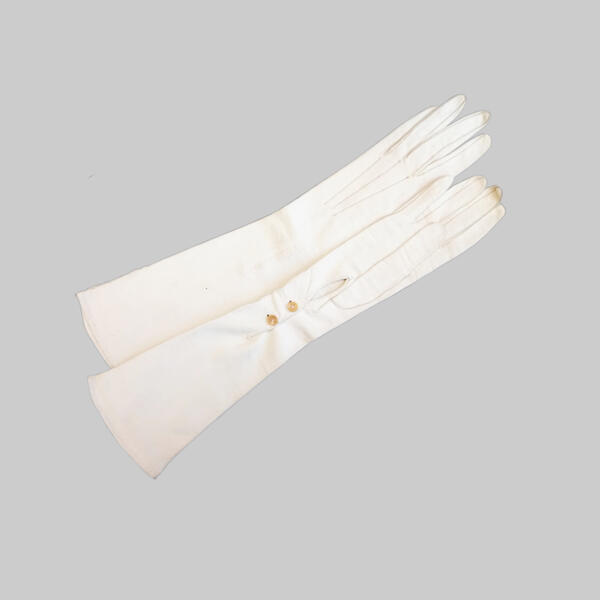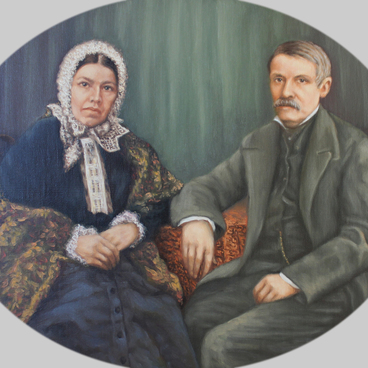These lady’s gloves, exhibited in the Decembrists in Yalutorovsk, joined the museum’s collection in 1994. They were acquired by museum staff during a business trip to St. Petersburg specifically for the exhibit in the memorial house of M.I. Muravyov-Apostol. These gloves are a good example of what accessories were worn in those years by those brought up in noble families.
Two girls were brought up in the family of Matvey and Maria Muravyov-Apostol: Avgusta Sozonovich and Anna Borodinskaya. They were taught not only literacy, but also the rules of good manners, as was customary in high society. In 1851, the pupils of Matvey Muravyov-Apostol spent some time in Tobolsk, where they accompanied the sick Ivan Yakushkin for treatment. A ball was organized for the auditor who came to Tobolsk. Alexander and Josephine Muravyov, with whom the girls stayed in Tobolsk, took Avgusta Sozonovich with them to the balls. An obligatory part of the ballroom costume were snow-white kidskin gloves, such as those presented in the exhibition.
In Russia in the 19th century, gloves were an integral part of a lady’s wardrobe. They were sewn from kidskin, a very thin leather. They were made very slim so that they perfectly follow the shape of the hand. There was a special way of checking glove quality: the glove was pulled through ladies’ rings. If they stretched easily, it meant that the gloves were of very high quality.
Ladies chose gloves to match their outfit color or specifically, pure white. Sometimes gloves were decorated with pearls, embroidery, and precious stones. Gloves made of kidskin were not only elastic and easily retained their shape, but also had a noble soft soft luster. From the mid-19th century, evening and ballroom gloves were wrist-length with a button cover. According to the rules of etiquette, gloves could not be removed throughout the ball. Arriving at a ball with naked hands was considered bad form. The presented ladies’ gloves of the second half of the 19th century are also made of white kidskin leather. The seams are finished with decorative stitching. The outer side of the glove is decorated with three lines arranged in the form of rays. On the inner middle side, there is a figured cutout with a fastener on two plastic buttons of light brown color.
Two girls were brought up in the family of Matvey and Maria Muravyov-Apostol: Avgusta Sozonovich and Anna Borodinskaya. They were taught not only literacy, but also the rules of good manners, as was customary in high society. In 1851, the pupils of Matvey Muravyov-Apostol spent some time in Tobolsk, where they accompanied the sick Ivan Yakushkin for treatment. A ball was organized for the auditor who came to Tobolsk. Alexander and Josephine Muravyov, with whom the girls stayed in Tobolsk, took Avgusta Sozonovich with them to the balls. An obligatory part of the ballroom costume were snow-white kidskin gloves, such as those presented in the exhibition.
In Russia in the 19th century, gloves were an integral part of a lady’s wardrobe. They were sewn from kidskin, a very thin leather. They were made very slim so that they perfectly follow the shape of the hand. There was a special way of checking glove quality: the glove was pulled through ladies’ rings. If they stretched easily, it meant that the gloves were of very high quality.
Ladies chose gloves to match their outfit color or specifically, pure white. Sometimes gloves were decorated with pearls, embroidery, and precious stones. Gloves made of kidskin were not only elastic and easily retained their shape, but also had a noble soft soft luster. From the mid-19th century, evening and ballroom gloves were wrist-length with a button cover. According to the rules of etiquette, gloves could not be removed throughout the ball. Arriving at a ball with naked hands was considered bad form. The presented ladies’ gloves of the second half of the 19th century are also made of white kidskin leather. The seams are finished with decorative stitching. The outer side of the glove is decorated with three lines arranged in the form of rays. On the inner middle side, there is a figured cutout with a fastener on two plastic buttons of light brown color.



